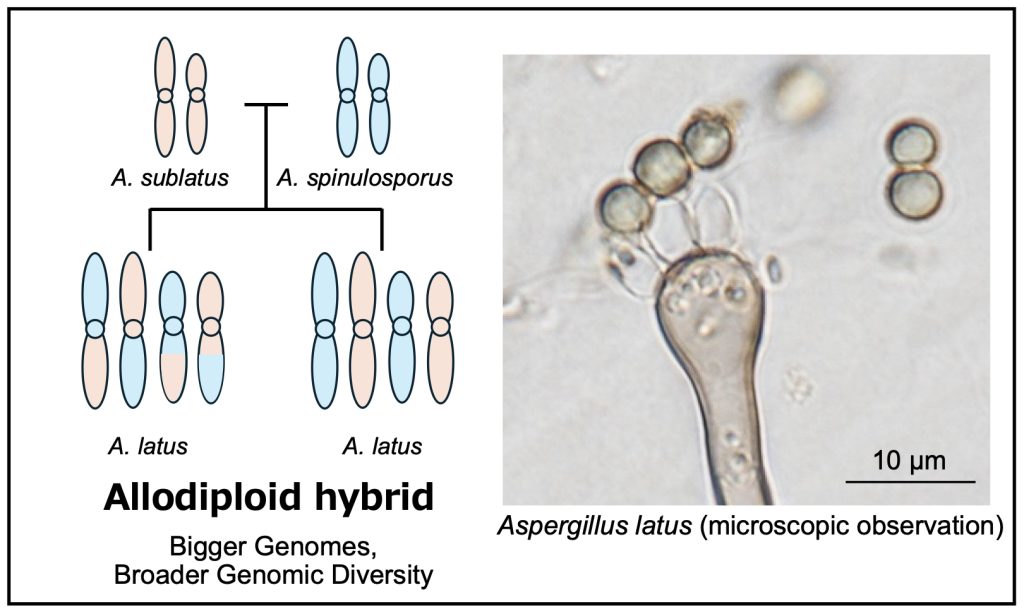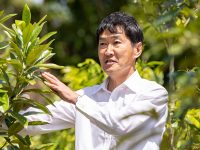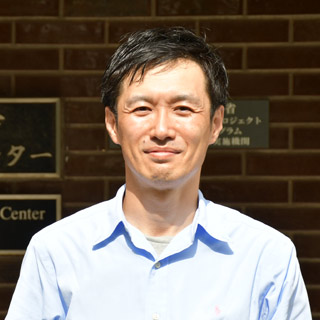Scientists discover ancestral evolutionary links of Aspergillus latus strains through in-depth genome sequencing analyses
Aspergillus, a common mold-forming fungus, can cause severe respiratory disease in patients with reduced immunity. Through screening 23 A. spinulosporus strains, researchers have identified, for the first time, seven clinical A. latus strains in patient samples. Their discovery of A. latus strains in samples obtained between 2012 and 2023 revealed a high misidentification rate of 30.4%. Continued surveillance and improved diagnostic tools can aid in the clinical management of Aspergillus infections.

Image title: Allodiploid hybrid nature of Aspergillus latus
Image caption: Through extensive phylogenetic analyses based on utilizing cloned copies of the calmodulin gene, researchers have mapped the evolutionary genetic relationships between Aspergillus spinulosporus and A. sublatus strains, giving rise to the allodiploid hybrid A. latus strain.
Image credit: Professor Hiroki Takahashi from Chiba University, Japan
Image license: Original content
Usage restrictions: Cannot be reused without permission.
Aspergillus is a fungus that is commonly found in the environment, both indoors and outdoors. This fungus species can cause aspergillosis—a respiratory infection affecting the lungs. A. fumigatus, A. nidulans, and A. niger are some of the common species within the Aspergillus genus that cause aspergillosis. In high-risk populations, such as immunocompromised individuals, aspergillosis can be life-threatening and lead to poor patient outcomes.
Previous research studies have identified A. latus as an allodiploid hybrid species containing gene sequences from two distinct species: A. spinulosporus and an unknown species related to A. quadrilineatus. Owing to its allodiploid hybrid nature, A. latus has been associated with both colonization and clinical disease, including invasive pulmonary aspergillosis, and some strains have shown reduced susceptibility to antifungal agents. Recent reports indicate that certain European and American aspergillosis cases could be attributed to A. latus. However, to date, A. latus strains have not been identified in clinical samples of patients in Japan.
To identify and characterize A. latus strains from clinical isolates and address the concerns around cryptic species of Aspergillus that lack definite and observable morphological characteristics, a team of researchers led by Associate Professor Hiroki Takahashi from the Medical Mycology Research Center, Chiba University, Japan, has conducted a new study. The research team comprised Dr. Saho Shibata, Dr. Momotaka Uchida, and Dr. Takashi Yaguchi from the Medical Mycology Research Center, Chiba University, along with Dr. Vit Hubka from the Czech Academy of Sciences, Czech Republic. Their findings were published in Volume 63, Issue 6 of Medical Mycology on June 10, 2025.
“The complexity of fungal pathogens and their resistance mechanisms presents both a fascinating scientific challenge and an important public health issue, which I am eager to explore,” says Dr. Takahashi, explaining the motivation behind the present study. Initially, the researchers analyzed 23 A. spinulosporus strains, which were collected between 2012 and 2023.
To accurately identify A. latus strains among the samples, the team utilized comprehensive phenotyping and genome sequencing analysis. The team identified seven A. latus strains among the 23 samples, which are clinically significant given that A. latus strains were not previously reported in Japan. Furthermore, through phylogenetic analyses, they observed that while one copy of the calmodulin gene aligned with the genetic sequence of A. spinulosporus, the other copy clustered with A. sublatus.
Inspired by their findings, the researchers went a step further and conducted antifungal susceptibility testing of different Aspergillus strains to antifungal medications. Japanese strains of A. latus showed reduced susceptibility to caspofungin and amphotericin B drugs. Also, genomic analysis revealed multiple amino acid insertions and deletions in one of the two alleles of the fks1 gene, which encodes a key component of the fungal cell wall biosynthesis machinery. This fks1 gene is associated with resistance to echinocandin-class antifungal drugs. The researchers suggest that if overlapping nucleotide signals are observed during gene sequencing—such as double peaks indicating the presence of two distinct alleles—then the possibility of hybrid species like A. latus should be considered in the diagnostic evaluation.
Highlighting the potential applications of the present study, Dr. Takahashi states, “By incorporating molecular phylogenetic and genomic analyses into diagnostic systems, our research is expected to improve the accuracy of fungal infection diagnoses and enable the selection of the most appropriate antifungal treatments for individual patients.”
Taken together, this study provides significant observations regarding the clinical relevance, prevalence, and potential role of A. latus as a disease-causing agent. Improved and reliable molecular diagnostic tools are vital for the accurate identification of A. latus strains and the subsequent management of aspergillosis.
About Associate Professor Hiroki Takahashi from Chiba University
Dr. Hiroki Takahashi serves as an Associate Professor at the Medical Mycology Research Center, Chiba University, Japan. He has been actively involved in projects for the systems biology of microorganisms in the division of bio-resources. His main topics of research include the transcriptome of fungi, mathematical models in microorganisms, and next-generation sequencing data analysis. Over the years, Dr. Takahashi has published 94 papers that have been cited more than 7,000 times.
Funding:
This work was partly supported by JSPS KAKENHI Grant Number JP24K19262 and the Institute for Fermentation, Osaka (Grant No. G-2025-1-006).
Reference:
Title of original paper: Aspergillus latus: A cryptic causative agent of aspergillosis emerging in Japan
Authors: Saho Shibata1, Momotaka Uchida1, Sayaka Ban1, Katsuhiko Kamei1, Akira Watanabe1, Takashi Yaguchi1, Vit Hubka2,3, and Hiroki Takahashi1,4,5,6
Affiliations: 1Medical Mycology Research Center, Chiba University, Japan
2Laboratory of Fungal Genetics and Metabolism, Czech Academy of Sciences, Czech Republic
3Department of Botany, Faculty of Science, Charles University, Czech Republic
4Faculty of Science, Chiba University, Japan
5Molecular Chirality Research Center, Chiba University, Japan
6Plant Molecular Science Center, Chiba University, Japan
Journal: Medical Mycology
DOI: 10.1093/mmy/myaf052
Contact: Hiroki Takahashi
Medical Mycology Research Center, Chiba University
Email: hiroki.takahashi@chiba-u.jp
Academic Research & Innovation Management Organization (IMO), Chiba University
Address: 1-33 Yayoi, Inage, Chiba 263-8522 JAPAN
Email: cn-info@chiba-u.jp
Recommend
-

Reassessing the role of “Forest Resources” in achieving carbon neutrality: Measuring forests with the combination of drones, mathematics, and computer graphics
2023.09.12
-

Designing a Comfortable Living: A Kampo Clinic that Simulates the Five Senses
2024.01.26
-

Towards a self-sustainable natural environment: The science of restoration ecology, where researchers engage in conversation with the earth
2023.02.02


